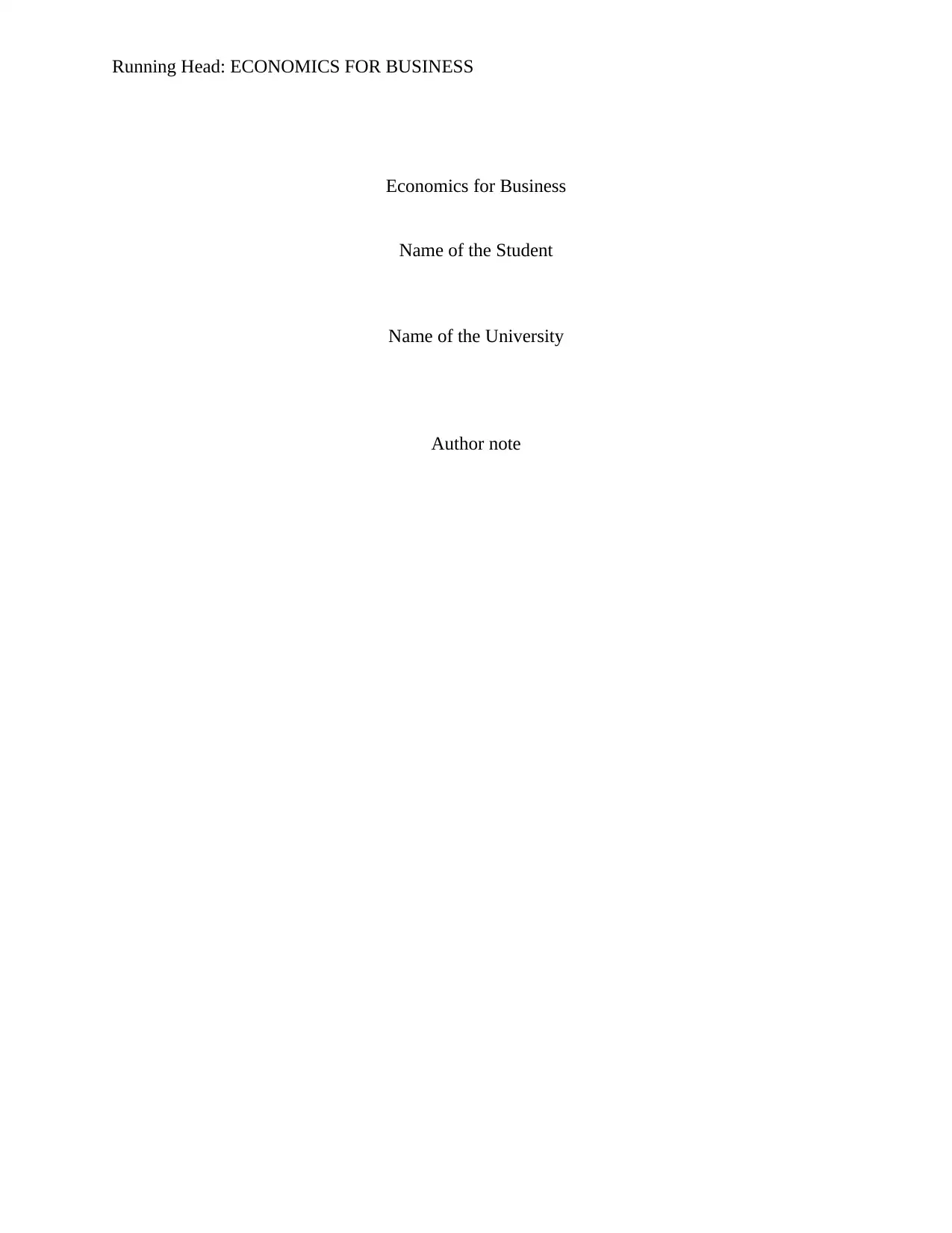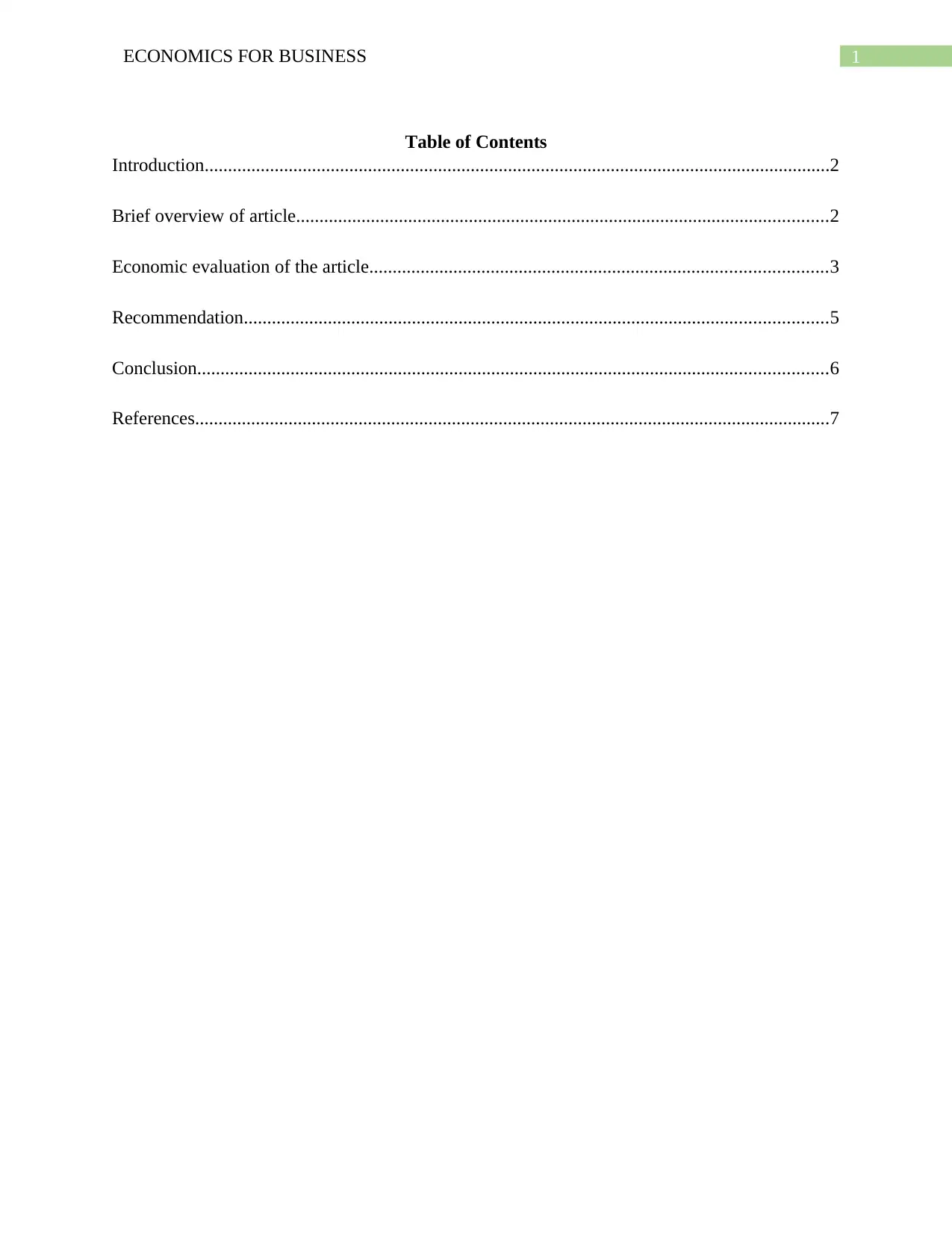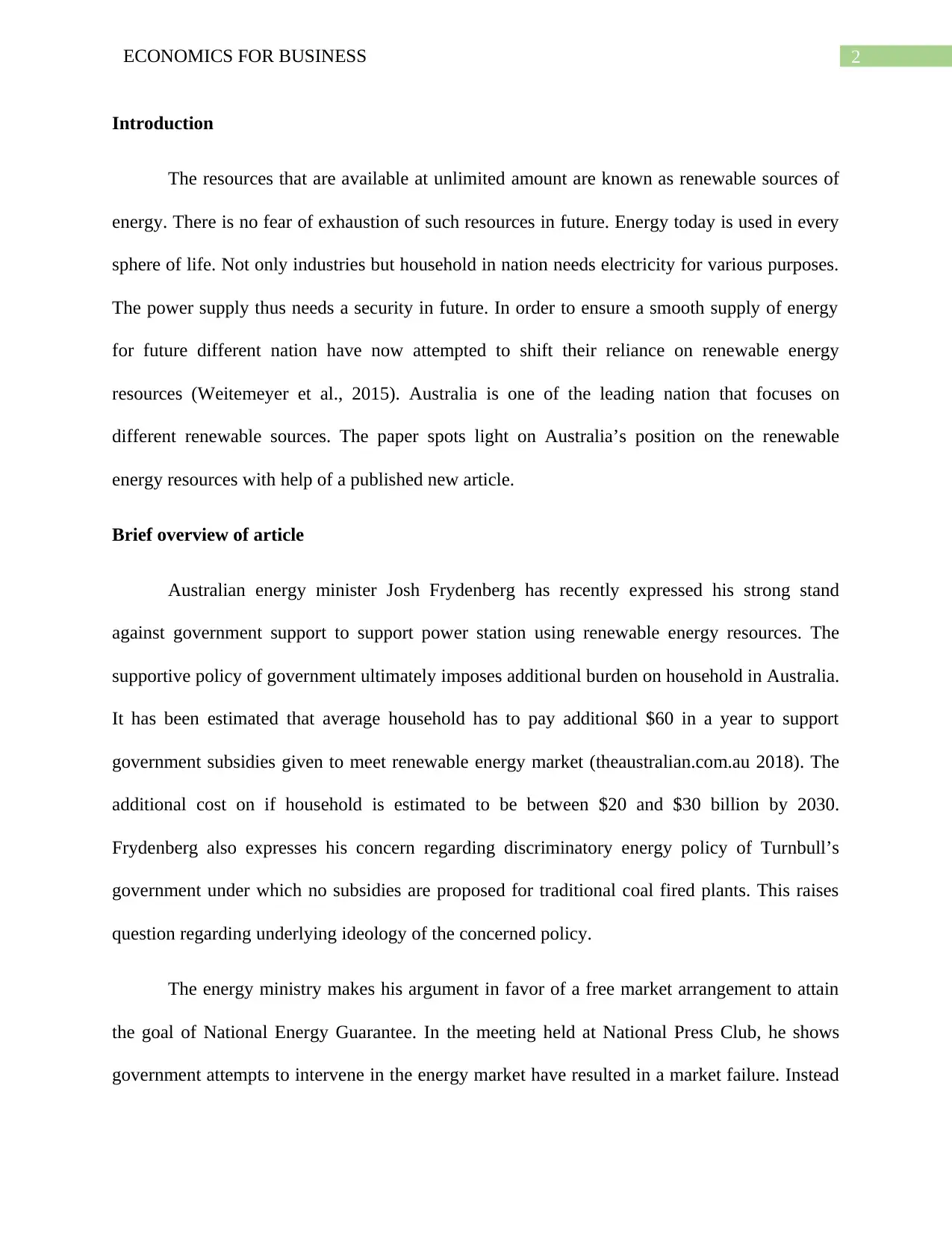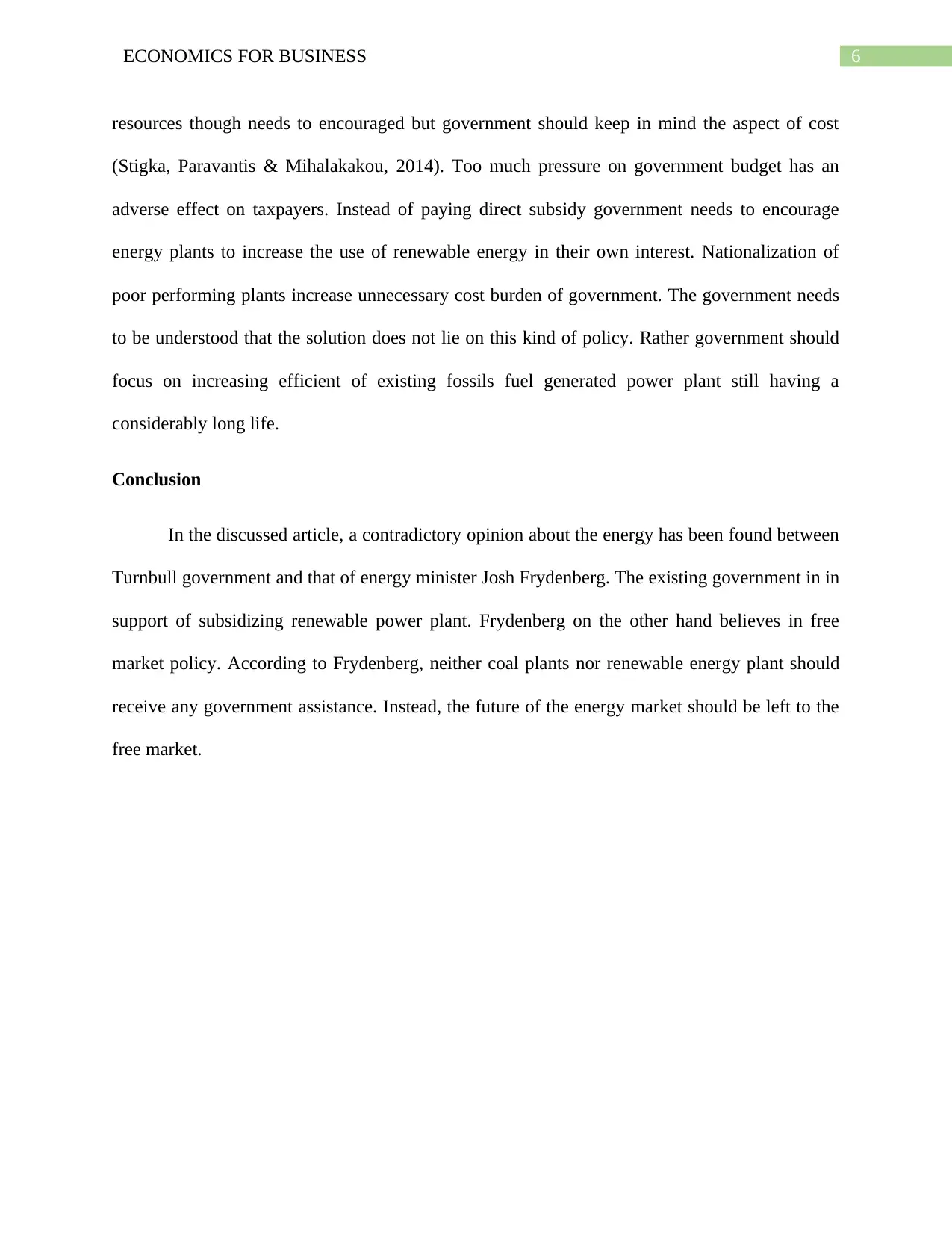Economics for Business: Analysis of Renewable Energy in Australia
VerifiedAdded on 2023/06/12
|9
|1466
|410
Report
AI Summary
This report provides an economic evaluation of Australia's approach to renewable energy, focusing on a recent article discussing Energy Minister Josh Frydenberg's stance against government subsidies for renewable energy sources. The report examines the economic arguments for and against subsidies, highlighting the potential cost burden on households and the benefits of a free market approach. It analyzes the efficiency of free markets in allocating resources and suggests that government intervention can lead to market failures. The report also considers the cost implications of subsidy policies and recommends that the government encourage renewable energy adoption through means other than direct subsidies, while also focusing on improving the efficiency of existing fossil fuel power plants. The analysis concludes by emphasizing the need for a balanced approach that considers both environmental goals and economic realities.

Running Head: ECONOMICS FOR BUSINESS
Economics for Business
Name of the Student
Name of the University
Author note
Economics for Business
Name of the Student
Name of the University
Author note
Paraphrase This Document
Need a fresh take? Get an instant paraphrase of this document with our AI Paraphraser

1ECONOMICS FOR BUSINESS
Table of Contents
Introduction......................................................................................................................................2
Brief overview of article..................................................................................................................2
Economic evaluation of the article..................................................................................................3
Recommendation.............................................................................................................................5
Conclusion.......................................................................................................................................6
References........................................................................................................................................7
Table of Contents
Introduction......................................................................................................................................2
Brief overview of article..................................................................................................................2
Economic evaluation of the article..................................................................................................3
Recommendation.............................................................................................................................5
Conclusion.......................................................................................................................................6
References........................................................................................................................................7

2ECONOMICS FOR BUSINESS
Introduction
The resources that are available at unlimited amount are known as renewable sources of
energy. There is no fear of exhaustion of such resources in future. Energy today is used in every
sphere of life. Not only industries but household in nation needs electricity for various purposes.
The power supply thus needs a security in future. In order to ensure a smooth supply of energy
for future different nation have now attempted to shift their reliance on renewable energy
resources (Weitemeyer et al., 2015). Australia is one of the leading nation that focuses on
different renewable sources. The paper spots light on Australia’s position on the renewable
energy resources with help of a published new article.
Brief overview of article
Australian energy minister Josh Frydenberg has recently expressed his strong stand
against government support to support power station using renewable energy resources. The
supportive policy of government ultimately imposes additional burden on household in Australia.
It has been estimated that average household has to pay additional $60 in a year to support
government subsidies given to meet renewable energy market (theaustralian.com.au 2018). The
additional cost on if household is estimated to be between $20 and $30 billion by 2030.
Frydenberg also expresses his concern regarding discriminatory energy policy of Turnbull’s
government under which no subsidies are proposed for traditional coal fired plants. This raises
question regarding underlying ideology of the concerned policy.
The energy ministry makes his argument in favor of a free market arrangement to attain
the goal of National Energy Guarantee. In the meeting held at National Press Club, he shows
government attempts to intervene in the energy market have resulted in a market failure. Instead
Introduction
The resources that are available at unlimited amount are known as renewable sources of
energy. There is no fear of exhaustion of such resources in future. Energy today is used in every
sphere of life. Not only industries but household in nation needs electricity for various purposes.
The power supply thus needs a security in future. In order to ensure a smooth supply of energy
for future different nation have now attempted to shift their reliance on renewable energy
resources (Weitemeyer et al., 2015). Australia is one of the leading nation that focuses on
different renewable sources. The paper spots light on Australia’s position on the renewable
energy resources with help of a published new article.
Brief overview of article
Australian energy minister Josh Frydenberg has recently expressed his strong stand
against government support to support power station using renewable energy resources. The
supportive policy of government ultimately imposes additional burden on household in Australia.
It has been estimated that average household has to pay additional $60 in a year to support
government subsidies given to meet renewable energy market (theaustralian.com.au 2018). The
additional cost on if household is estimated to be between $20 and $30 billion by 2030.
Frydenberg also expresses his concern regarding discriminatory energy policy of Turnbull’s
government under which no subsidies are proposed for traditional coal fired plants. This raises
question regarding underlying ideology of the concerned policy.
The energy ministry makes his argument in favor of a free market arrangement to attain
the goal of National Energy Guarantee. In the meeting held at National Press Club, he shows
government attempts to intervene in the energy market have resulted in a market failure. Instead
⊘ This is a preview!⊘
Do you want full access?
Subscribe today to unlock all pages.

Trusted by 1+ million students worldwide

3ECONOMICS FOR BUSINESS
the traditional and renewable power plants should be subject to open market competition. In the
competition the winner will determine the future of energy supply in Australia from the open
market battle the nation will have its future source of power generation that will fulfill an
estimated energy infrastructure worth of $200 billion in near future (by 2050).
The former prime minister Tony Abott suggested that government Australian government
should overtake Liddell power plan to extend life of the concerned plant. Josh Frydenberg is in
view that war between energy sources or forced nationalization are the two extreme condition
and makes the nation no better off. The energy policy decision is mostly based on ideology
rather than consideration of technical efficiency. In order to meet clean energy, target the use of
fossil fuel should be reduced. The existing power plants in Australia that uses fossils fuels have
an estimated average life of 27 years (bloomberg.com 2018). Proposition has been made to end
subsidies on new projects of renewable energy as it costs heavily to the household who have to
pay a high tax.
Economic evaluation of the article
The efficiency of free market first identified by classical economist. Under free market
demand and supply forces are left independent to work in the market. The interaction of supply
and demand forces determines optimal combination of price and output in the market. The free
market thus ensures efficient resource allocation maximizing social welfare (Kates, 2017). The
price mechanism known as invisible hand restores equilibrium in the market. Government
intervention in the free market leads mismanagement of resources and thus adversely affect
optimal functioning of the market.
the traditional and renewable power plants should be subject to open market competition. In the
competition the winner will determine the future of energy supply in Australia from the open
market battle the nation will have its future source of power generation that will fulfill an
estimated energy infrastructure worth of $200 billion in near future (by 2050).
The former prime minister Tony Abott suggested that government Australian government
should overtake Liddell power plan to extend life of the concerned plant. Josh Frydenberg is in
view that war between energy sources or forced nationalization are the two extreme condition
and makes the nation no better off. The energy policy decision is mostly based on ideology
rather than consideration of technical efficiency. In order to meet clean energy, target the use of
fossil fuel should be reduced. The existing power plants in Australia that uses fossils fuels have
an estimated average life of 27 years (bloomberg.com 2018). Proposition has been made to end
subsidies on new projects of renewable energy as it costs heavily to the household who have to
pay a high tax.
Economic evaluation of the article
The efficiency of free market first identified by classical economist. Under free market
demand and supply forces are left independent to work in the market. The interaction of supply
and demand forces determines optimal combination of price and output in the market. The free
market thus ensures efficient resource allocation maximizing social welfare (Kates, 2017). The
price mechanism known as invisible hand restores equilibrium in the market. Government
intervention in the free market leads mismanagement of resources and thus adversely affect
optimal functioning of the market.
Paraphrase This Document
Need a fresh take? Get an instant paraphrase of this document with our AI Paraphraser

4ECONOMICS FOR BUSINESS
Figure 1: Free market equilibrium
(Source: as created by Author)
In a free market, if price rises above or below the equilibrium price, then the market faces
a short term shortage in either demand or supply. The price then automatically adjusted to reach
to the equilibrium level. Following the efficiency of free market, Josh Frydenberg suggests to
pursue a free market policy in the energy market. Proposition has made to provide equal
opportunity to both coal plants and that of renewable energy plants. The Turnbull government
designs subsidy only for renewable energy plants (theguardian.com, 2018). These subsidies
should be eliminated to provide opportunity for a fair competition. In the competition, the wining
plants will be prepared to meet future energy infrastructure of the nation.
Figure 1: Free market equilibrium
(Source: as created by Author)
In a free market, if price rises above or below the equilibrium price, then the market faces
a short term shortage in either demand or supply. The price then automatically adjusted to reach
to the equilibrium level. Following the efficiency of free market, Josh Frydenberg suggests to
pursue a free market policy in the energy market. Proposition has made to provide equal
opportunity to both coal plants and that of renewable energy plants. The Turnbull government
designs subsidy only for renewable energy plants (theguardian.com, 2018). These subsidies
should be eliminated to provide opportunity for a fair competition. In the competition, the wining
plants will be prepared to meet future energy infrastructure of the nation.

5ECONOMICS FOR BUSINESS
Figure 2: Cost of Subsidy
(Source: Kates, 2017)
Another argument that has been made again subsidy policy is the associated cost of
subsidy. Objective of government subsidy program is to encourage producer to expand
production by reducing the effective cost. Under subsidy policy, goods are offered to final
consumers at a low price. Buyers though pays a low price sellers producers however receives
high price (Stiglitz & Rosengard 2015). The objective of subsidy program in the renewable
power sector is thus to provide electricity at a cheaper cost and encourage producers to use more
and more renewable energy in order to meet clean energy target. The subsidy however entails
huge cost on government (reneweconomy.com.au, 2018). The cost burden ultimately sets on
Australian households who end up paying additional dollar amount in a year.
Recommendation
The government support to renewable power plants in form of subsidy is found to impose
additional cost burden on household. The power generation by means of renewable energy
Figure 2: Cost of Subsidy
(Source: Kates, 2017)
Another argument that has been made again subsidy policy is the associated cost of
subsidy. Objective of government subsidy program is to encourage producer to expand
production by reducing the effective cost. Under subsidy policy, goods are offered to final
consumers at a low price. Buyers though pays a low price sellers producers however receives
high price (Stiglitz & Rosengard 2015). The objective of subsidy program in the renewable
power sector is thus to provide electricity at a cheaper cost and encourage producers to use more
and more renewable energy in order to meet clean energy target. The subsidy however entails
huge cost on government (reneweconomy.com.au, 2018). The cost burden ultimately sets on
Australian households who end up paying additional dollar amount in a year.
Recommendation
The government support to renewable power plants in form of subsidy is found to impose
additional cost burden on household. The power generation by means of renewable energy
⊘ This is a preview!⊘
Do you want full access?
Subscribe today to unlock all pages.

Trusted by 1+ million students worldwide

6ECONOMICS FOR BUSINESS
resources though needs to encouraged but government should keep in mind the aspect of cost
(Stigka, Paravantis & Mihalakakou, 2014). Too much pressure on government budget has an
adverse effect on taxpayers. Instead of paying direct subsidy government needs to encourage
energy plants to increase the use of renewable energy in their own interest. Nationalization of
poor performing plants increase unnecessary cost burden of government. The government needs
to be understood that the solution does not lie on this kind of policy. Rather government should
focus on increasing efficient of existing fossils fuel generated power plant still having a
considerably long life.
Conclusion
In the discussed article, a contradictory opinion about the energy has been found between
Turnbull government and that of energy minister Josh Frydenberg. The existing government in in
support of subsidizing renewable power plant. Frydenberg on the other hand believes in free
market policy. According to Frydenberg, neither coal plants nor renewable energy plant should
receive any government assistance. Instead, the future of the energy market should be left to the
free market.
resources though needs to encouraged but government should keep in mind the aspect of cost
(Stigka, Paravantis & Mihalakakou, 2014). Too much pressure on government budget has an
adverse effect on taxpayers. Instead of paying direct subsidy government needs to encourage
energy plants to increase the use of renewable energy in their own interest. Nationalization of
poor performing plants increase unnecessary cost burden of government. The government needs
to be understood that the solution does not lie on this kind of policy. Rather government should
focus on increasing efficient of existing fossils fuel generated power plant still having a
considerably long life.
Conclusion
In the discussed article, a contradictory opinion about the energy has been found between
Turnbull government and that of energy minister Josh Frydenberg. The existing government in in
support of subsidizing renewable power plant. Frydenberg on the other hand believes in free
market policy. According to Frydenberg, neither coal plants nor renewable energy plant should
receive any government assistance. Instead, the future of the energy market should be left to the
free market.
Paraphrase This Document
Need a fresh take? Get an instant paraphrase of this document with our AI Paraphraser

7ECONOMICS FOR BUSINESS
References
Kates, S. (2017). Free market economics: An introduction for the general reader. Edward Elgar
Publishing.
Murphy, K. (2018). Frydenberg refuses to repent as Alan Jones tries to exorcise energy
blasphemy | Katharine Murphy. the Guardian. Retrieved 26 April 2018, from
https://www.theguardian.com/australia-news/2018/apr/26/frydenberg-refuses-to-repent-
as-alan-jones-tries-to-exorcise-energy-blasphemy
Parkinson, G. (2018). Monash manifesto: Coal subsidies good, renewable targets
bad. RenewEconomy. Retrieved 26 April 2018, from
https://reneweconomy.com.au/monash-manifesto-coal-subsidies-good-renewable-targets-
bad-67091/
Power generation is a matter of free market, Fryfdenberg argues. (2018). Theaustralian.com.au.
Retrieved 26 April 2018, from https://www.theaustralian.com.au/national-affairs/power-
generation-a-matter-for-the-free-market-frydenberg-argues/news-story/
3e4f2a7d7e3a5edbe6d98d4c6623d330
Stigka, E. K., Paravantis, J. A., & Mihalakakou, G. K. (2014). Social acceptance of renewable
energy sources: A review of contingent valuation applications. Renewable and
Sustainable Energy Reviews, 32, 100-106.
Stiglitz, J. E., & Rosengard, J. K. (2015). Economics of the Public Sector: Fourth International
Student Edition. WW Norton & Company.
References
Kates, S. (2017). Free market economics: An introduction for the general reader. Edward Elgar
Publishing.
Murphy, K. (2018). Frydenberg refuses to repent as Alan Jones tries to exorcise energy
blasphemy | Katharine Murphy. the Guardian. Retrieved 26 April 2018, from
https://www.theguardian.com/australia-news/2018/apr/26/frydenberg-refuses-to-repent-
as-alan-jones-tries-to-exorcise-energy-blasphemy
Parkinson, G. (2018). Monash manifesto: Coal subsidies good, renewable targets
bad. RenewEconomy. Retrieved 26 April 2018, from
https://reneweconomy.com.au/monash-manifesto-coal-subsidies-good-renewable-targets-
bad-67091/
Power generation is a matter of free market, Fryfdenberg argues. (2018). Theaustralian.com.au.
Retrieved 26 April 2018, from https://www.theaustralian.com.au/national-affairs/power-
generation-a-matter-for-the-free-market-frydenberg-argues/news-story/
3e4f2a7d7e3a5edbe6d98d4c6623d330
Stigka, E. K., Paravantis, J. A., & Mihalakakou, G. K. (2014). Social acceptance of renewable
energy sources: A review of contingent valuation applications. Renewable and
Sustainable Energy Reviews, 32, 100-106.
Stiglitz, J. E., & Rosengard, J. K. (2015). Economics of the Public Sector: Fourth International
Student Edition. WW Norton & Company.

8ECONOMICS FOR BUSINESS
Weitemeyer, S., Kleinhans, D., Vogt, T., & Agert, C. (2015). Integration of Renewable Energy
Sources in future power systems: The role of storage. Renewable Energy, 75, 14-20.
Williams, M., & Scott, M. (2018). Australia Edges Toward New Energy Policy After Decade of
Turmoil. Bloomberg.com. Retrieved 26 April 2018, from
https://www.bloomberg.com/news/articles/2018-04-20/australia-edges-toward-new-
energy-policy-after-decade-of-turmoil
Weitemeyer, S., Kleinhans, D., Vogt, T., & Agert, C. (2015). Integration of Renewable Energy
Sources in future power systems: The role of storage. Renewable Energy, 75, 14-20.
Williams, M., & Scott, M. (2018). Australia Edges Toward New Energy Policy After Decade of
Turmoil. Bloomberg.com. Retrieved 26 April 2018, from
https://www.bloomberg.com/news/articles/2018-04-20/australia-edges-toward-new-
energy-policy-after-decade-of-turmoil
⊘ This is a preview!⊘
Do you want full access?
Subscribe today to unlock all pages.

Trusted by 1+ million students worldwide
1 out of 9
Related Documents
Your All-in-One AI-Powered Toolkit for Academic Success.
+13062052269
info@desklib.com
Available 24*7 on WhatsApp / Email
![[object Object]](/_next/static/media/star-bottom.7253800d.svg)
Unlock your academic potential
Copyright © 2020–2025 A2Z Services. All Rights Reserved. Developed and managed by ZUCOL.





